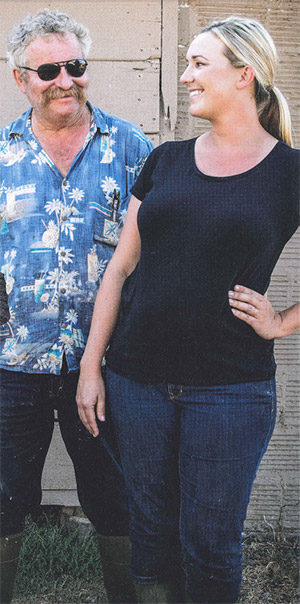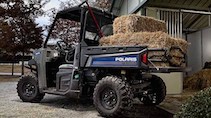The Boeres
-
 Names: John (father) and Laura (daughter) Boere
Names: John (father) and Laura (daughter) Boere - Children: Laura, 31, is newly married; her first child is due in December.
- Operation: John Boere Dairy, Modesto, Calif.
- Livestock: 450 milk cows
- AGCO Equipment: Massey Ferguson 396, Massey Ferguson 573, Massey Ferguson 4225. Laura's dad, John Boere, says they've run the MF396 10,000 hours and "never had the motor or transmission apart." The father-daughter team uses the MF573 daily to put up hay for the cows, and they use the MF4225 to mow pasture. "We like to keep them hooked up, so they just keep going," notes John.
- Dealer: Holt Ag Solutions, Salida, Calif.
- Goal: To keep the longtime family dairy running well into the future, despite escalating land prices and lack of expansion opportunities locally.
Laura Boere has been working alongside her dad on the family dairy farm ever since she was a little girl. Since then, however, she's gotten a promotion of sorts. Her full-time role on the farm now is primarily as a manager, keeping the books, overseeing summer irrigation and managing the farm's eight full-time employees.
Together with her dad, John, she manages 200 owned acres and another 130-plus of leased land. Their dairy has been organic since 1999. "We wanted to get away from chemicals and enjoy more stable prices," explains John.
Even though the Boeres enjoy higher prices for their milk as organic producers, John remains worried about the farm's future. "It's a difficult industry," he says of the dairy business. "There are only 1,400 dairies left in California. When I started [in 1988], there were 2,400." He remains concerned that increasing regulations on farmers in the state, along with escalating land prices, will continue to shrink the industry in the future.
Learning, Land and the Long Game
"It's not just a job," Laura says of her role at the dairy. "It's a business with a lot of responsibility, and it requires a lot of dedication and hard work." Like most dairy producers, Laura gets that this line of work runs 24 hours a day, seven days a week.
She has worked full time on the family dairy since she was 19, and is inheriting a legacy that began when her great-great-great-grandfather started a dairy in Long Beach in 1905. The Boere staying power is noteworthy. "My dad had a dairy till he was 80 years old," remarks John. And the Boere family still holds a 179-year-old dairy in the Netherlands.
Laura says learning to run the dairy has been more a process of "absorption" rather than direct instruction on the part of her father. As she has gone about daily tasks with him at her side, she has learned about managing the herd, how to irrigate, the importance of real estate and what it's worth.
Laura is grateful she was born into the industry and has a foot naturally in the door. Farmland is a precious commodity in California, scooped up as soon as it hits the market. And it's not cheap to lease land either. "It goes for $300 or $900 per acre depending on what you're growing," says John. "There's no way possible Laura could have started this on her own."
Old Lessons Still Apply
The Boeres have faced stiff competition from almond growers in the land leasing department, so much so that the father-daughter team is about to purchase 824 acres in the Sierra Nevada, an hour's drive from the dairy. They will have to move their cattle back and forth to graze.
Married to a tree farmer, Laura is acutely aware of how the agricultural industry has changed… and in a way that certainly isn't conducive to getting started as a farmer without a family connection. "When I was young, I worked for my dad," says John. "I saved money hauling manure and had $50,000 in the bank by age 25. I bought a small farm, a house and used that property as collateral to start a dairy." Given land appreciation in the Golden State, it's a feat few young farmers could pull off today.
High prices or not, John says the critical thing he has tried to pass onto Laura is the importance of conservative spending. "People today live too high on the hog," he remarks. "I started with one heifer while working for my dad, and every time I sold one I kept multiplying," he adds, referring to the growth of his herd.
Advice to Young Farmers
"Hands-on learning has been key for me," says Laura. "And I know there are a lot of aging farmers out there who would love to find a young farmer work for them." She encourages young producers, who haven't enjoyed the benefit of being born into the industry, to find an old farmer and offer to work for him or her. She believes plenty of farmers who have seen their kids leave the land (as three of Laura's siblings have) would rather train someone outside the family to work the farm and find a way to pass it along to them, than see it sold off to a corporation or a developer.
Laura also encourages would-be farmers to get an education. "Go to college," she urges. Farming today has become so complex, one really can't be successful in ag operations without a four-year degree anymore.
Then Laura reiterates, "find a farmer to work for, and start learning".
– FarmLife


 Farm Tax Exemption Form
Farm Tax Exemption Form